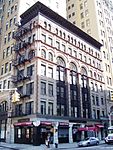Art in General

Art in General was a non-profit contemporary art exhibition space known for its vibrant and ground-breaking projects as a formidable and longstanding New York City alternative space, focused on giving meaningful resources and opportunities to artists early on in their careers. Founded in 1981 by artists Martin Weinstein and Teresa Liszka and originally located in the General Hardware building in New York City — hence the organization's name, Art in General — the institution produced and presented distinctive programs and exhibitions featuring new work by local and international artists.[1] Since its first exhibition in 1982, Art in General provided spaces for artists to display unconventional work and exchange ideas with their peers for almost 40 years, making it one of the longest-standing artist-founded non-profit artist organizations in New York City. Art in General organized exhibitions; commissions new art projects; hosted national and international artist residency programs; and facilitated regular free public programs with renowned artists, critics and curators. More than 2,000 artists exhibited their work at Art in General in a wide range of disciplines—painting, sculpture, drawing, photography, installation art, audio, video art, performance art and new media art.
Excerpt from the Wikipedia article Art in General (License: CC BY-SA 3.0, Authors, Images).Art in General
Walker Street, New York Manhattan
Geographical coordinates (GPS) Address Nearby Places Show on map
Geographical coordinates (GPS)
| Latitude | Longitude |
|---|---|
| N 40.718097222222 ° | E -74.001844444444 ° |
Address
Walker Street 81
10013 New York, Manhattan
New York, United States
Open on Google Maps





